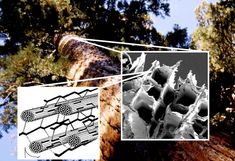Structure and properties of biological materials
Biological materials typically exhibit an intricate hierarchical structure that is optimized to fulfill specific functions and withstand specific loading patterns. Structural optimization is particularly prominent in high-performance lightweight materials such as bone or wood, but also in teeth, sea shells and insect cuticle. We study the influence of the structure on the deformation behavior of biological composite materials on several length scales. A special focus lies on wood. By combining tensile testing, fracture mechanics and structure investigation with electron microscopy and scattering methods we aim at a systematic understanding of the relationship between structural features and mechanical performance. This knowledge is the basis for the development of new, bio-inspired materials. Contact: G. Sinn, H. Lichtenegger
Biocompatible and bio-resorbable medical implant materials
Medical implant materials have to meet extremely high requirements concerning biocompatibility, stability and long term behavior in the body. We study the mechanical properties and degradation of implant materials and also of the biological tissue itself, with special focus on bone. Since bone is a highly responsive material, it reacts to local changes in load by remodeling and changing its shape and structure. For our studies we use a variety of state of the art methods like micro- and nanoindentation, electron microscopy, mechanical testing, x-ray scattering etc. in order to contribute to the development of implant materials, e.g. novel bio-resorbable implants that are replaced by bone tissue with time. Contact: S. Tschegg, H. Lichtenegger
Materials with bio-inspired architecture
In Nature, high-performance lightweight materials with tailored mechanical properties are obtained by exquisite control of the architecture down at all size levels to the nanometer scale. Materials such as insect cuticle, wood or bone are fiber composites featuring strictly controlled arrangement and preferred orientation of structural components. We focus on the study and development of bio-inspired nanocomposite materials that follow natural principles by implementing controlled arrangement and/or orientation of nanofillers – based on natural components, hybrid systems or purely synthetic components (e.g. carbon nanotubes) - in order to fabricate new materials with tailored mechanical properties, such as lightweight nanocomposites for aerospace applications. Contact: H. Lichtenegger



